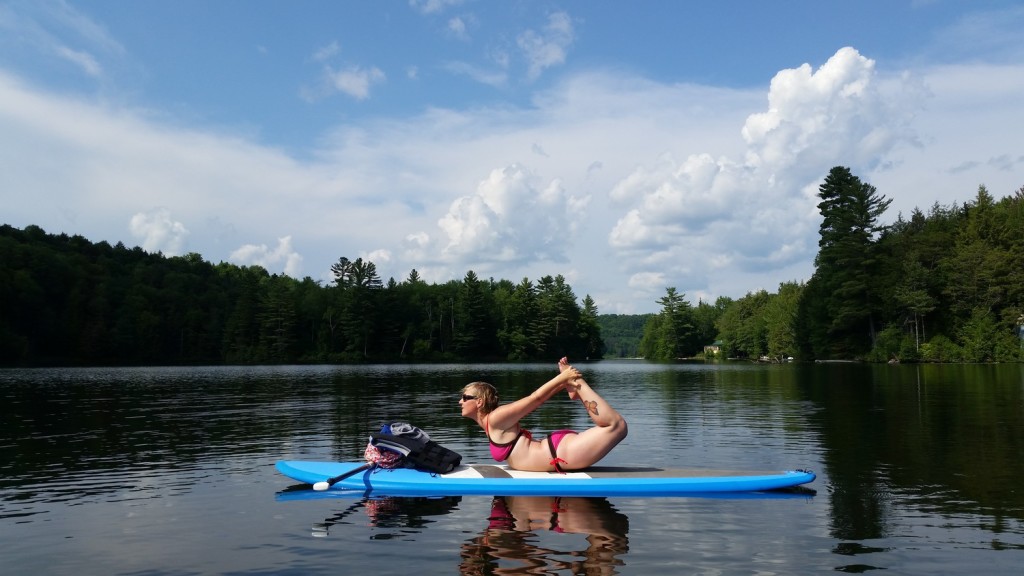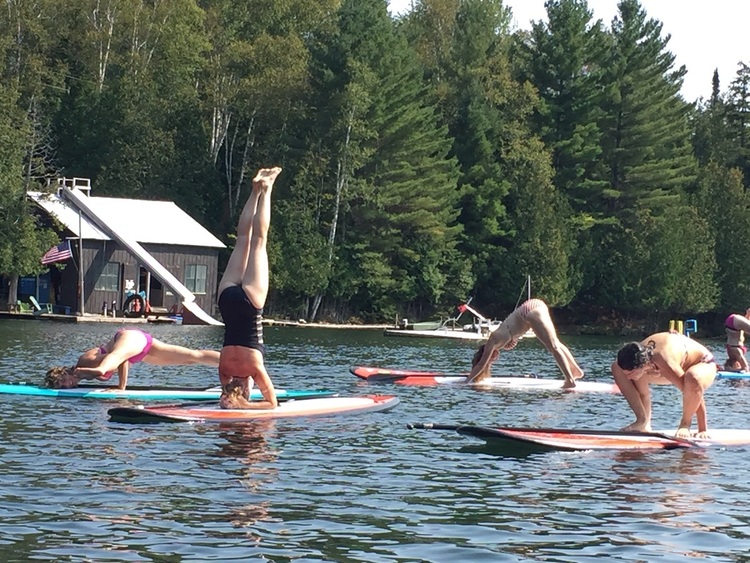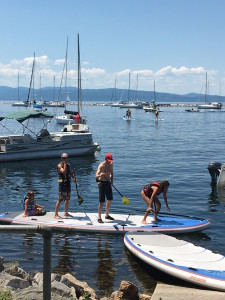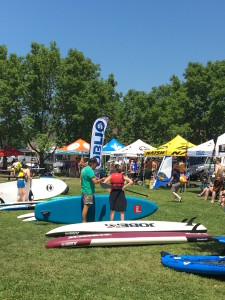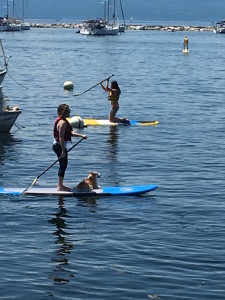Respect the impact of summer elements on your exercise.
You either like the heat, or you don’t. Those who live in Vermont because they prefer cooler temperatures, and snow and winter sports, just might start to complain when the thermometer hits 70 degrees. Others luxuriate in the penetrating heat of a sunny Vermont day. Both camps often agree, however, that high heat combined with elevated humidity often cause a game change.
In any event, longer daylight hours married to pleasing temperatures lure most outdoors. An added bonus is how little one needs to wear in summer versus winter conditions.
That does not mean, however, that one should be unprepared for what summer elements may produce.
— Weather: It may change any minute. If it rains, will you be prepared? Be sure to check the forecast. Right or wrong, it will at least give you a good idea of what is possible. Above all, avoid getting caught unprepared when dangerous lightening strikes.
— Heat: The condition of heat exhaustion is preventable; heat stroke is deadly. Learn the symptoms and treatments for both (see, for example, www.mayoclinic.org). Your troubles may appear initially as heat cramps. If these escalate to dizziness, hot and clammy skin, rapid pulse, headache, nausea, fatigue (to name a few symptoms), it’s time to take action. Or rather, it’s time to stop, find a cooler place (even the shade of a tree) and hydrate with water or a sports drink. Untreated, heat exhaustion can become unmanageable and dangerous. If symptoms continue for an hour and body temperature is elevated to 104 F or above, seek immediate medical attention.
A warm, dry day is an excellent time to get outdoors to train for a sport or participate in a game, competition or event. However, if conditions are adverse, best to err on the side of caution: Play it safe, dial it back, reduce the intensity or length of your training, take special care to hydrate well and spend every available minute out of the direct sun.
— Wind: Unintended consequences prevail when one embarks on an adventure on a windy day. When checking the weather forecast, also be sure to note the wind. When cycling, paddling or running, for example, a headwind is disadvantageous because of the effort involved. Yet a tailwind, though often an exciting relief, just might be more than you bargained for. On water it’s easy to be blown off course, and on a bike those pesky cross winds can be unsettling. Wind is also unexpectedly dehydrating.
— First aid: It’s smart to refresh your memory of basic first-aid and to pack along a few simple aids that could make the difference between a blip on the day and a sad experience.
— Bugs and bee stings: Oh my; these do come with the territory. Some people seem to attract insects more than others. Know your personal tolerance level and bring along whatever you need to protect yourself whether it’s a topical spray or lotion or long sleeves and pant legs, or even netting. If, of course, you are allergic to bee stings, always be prepared with an EpiPen (epinephrine injection) or whatever antidote you use, and inform your companions of your allergy.
— Poisonous plants: Learn to identify poisonous plants such as ivy, oak, sumac, parsnips, and even common plants such as sunflowers wild grapes and clematis (www.uvm.edu). Reactions to toxins from these plants vary in different individuals.
Surely when your work is in the outdoors, choices are limited and precautions take on new meaning. If, however, you are off for a day of fun, think ahead to insure a safe and pleasant outing for yourself and those with whom you spend your hours.
— Sun protection: Finally, by now, unless you live on another planet, you have heard repeated warnings to protect your skin from the ravages of skin cancer due to exposure to the sun’s harmful rays. Apply and reapply sunscreen as needed.
Read below to see what Kimberly Evans, a registered dietitian, has to say about nutrition and the sun.
EDIBLE SUNSCREEN
by Kimberly Evans, MS, RD.
The sunscreen dilemma is a frequent problem with athletes and outdoor enthusiasts come summer. One might think that this is a no brainer. After all, for a very long time now we have been programmed to lather up on sunblock before we even step outside. You do this to protect your skin from harmful sunrays, and therefore protect your skin from cancer. For the most part, we can all agree that skin protection is an important consideration for those who are active outside in the summer months.
But wait, there are some cons; maybe even more cons than pros. For one, not only does sunblock keep out harmful sun rays, it also keeps out very beneficial Vitamin D. Vitamin D is a crucial hormone-like-vitamin that not only keeps athlete’s immune systems healthy, but also plays a role in preventing stress fractures and other sports-related injuries.
It is a good practice for active people to get vitamin D levels tested once a year, especially if they are sun-avoidant or heavy sun block users. Salmon and mushrooms are a great natural source of Vitamin D, but many folks find that they need to take supplemental Vitamin D3.
Another very real sun block con is that many sunscreens are loaded with harmful chemicals, commonly referred to as endocrine disruptors.
The skin is the largest organ of the body and creams, oils, and lotions applied to the skin quickly make their way into the blood stream. Chemicals such as PABA, paraben, sulphates, phthalates, oxybenzone, and forms of Vitamin A are common sunscreen additives.
If you lather up before going outside, a good rule of thumb is to choose a sunscreen that has strong broad spectrum UVA and UVB protection, such as those containing zinc oxide. Badger All-Natural Sunscreen and Aubrey Organics are two good examples.
The Environmental Working Group (a non-profit research group focused on public health protection) has several guides to choosing a good sunscreen, as well as several interesting articles such as “Eight Little Known Facts About Sunscreens.”
As a registered dietitian and food enthusiast, I find there is always a celebration to be had when food comes to the rescue. In my world it often does. Beyond topical sunscreen, foods themselves can offer sun protection for the skin.
The next time you are heading out for a run, hike, bike, walk, swim, round of golf or any other outdoor activity, plan a meal where you can eat your sun block or take sun protecting snacks along.
Wait, what? Yes. I am not talking about finding an edible sunscreen here. I am saying that many foods in your kitchen contain natural protection against solar radiation.
The phytochemicals in foods actually make their way to the upper layers of your skin, increasing resistance to UV damage. Think of these foods as part of your summer medicine cabinet that can be found in your kitchen and your garden.
Here are the top foods that offer skin protection.
TOMATOES. Tomatoes contain lycopene, a phytochemical that has been shown to protect the skin against sunburn. This protein is enhanced by olive oil and cooking the tomatoes. (Bruschetta anyone?)
AVOCADOS. The oils in avocados help protect the skin from damaging effects of the sun. Avocados make a great addition to a smoothie, a salad, or as a sandwich spread. (Although I have been known to simply cut them in half and eat with a spoon right out of the skin.)
APPLES, particularly red apples. The triterpenoids in the skin of apples fight cancer cells by inducing apoptosis, or death of cancer cells.
GREEN TEA. The catechins in green tea offer skin protection. Make a goal of two cups per day. Green tea can be a good liquid to add to a smoothie, use in a sports drink or to make a simple iced tea.
CITRUS. Beyond the healing properties of the Vitamin C found in citrus, the essential oils found in the skin of lemons, limes, and all citrus contain limonene, an essential oil that offers a dose of skin protein when eaten. Zest lemons or limes into your tea (hot or iced) or even onto a nut butter sandwich. (Trust me on this one; it is delish.)
OMEGA – RICH FOODS. Salmon, flaxseeds, and chia seeds are omega powerhouses. The omega-3 fats act as sunscreen and have been shown to decrease squamous cell skin cancer by 20%.
POMEGRANATES are rich in ellagic acid and support glutathione production in the body. These phytonutrients offer antioxidant protection and fight skin damage caused by free radicals. Pomegranate juice is always available and makes a tasty pink lemonade.
Pomegranates also make an excellent addition to guacamole. This is a win-win. Try this recipe.
Pomegranate Guacamole
2 ripe avocados
¼ cup diced red onions
3 TBSP freshly squeezed lime juice
1 tsp salt
½ cup finely diced cilantro (mint or parsley can be used for those non-cilantro lovers – cut down to ¼ cup)
½ cup pomegranate seeds
Halve and pit the avocados and scoop out the flesh with a spoon into a bowl. Add red onion, lime juice, salt, and cilantro to the bowl. Mash the mixture together with a fork. Stir in pomegranate seeds and serve with chips or crudité (jicama is very nice here)
If you are active outside in the summer, add these foods to your shopping list. Food does not need to replace sunblock entirely, but it can work together with it to increase its effectiveness in a most tasty and delicious way. Culinary medicine is a growing science that combines the art of cooking with the emerging science of nutrition, genomics, and biochemistry. Eating your way to skin protection is just one example of culinary medicine.
To contact Evans, email Kimberly@wholehealthnutritionvt.com or visit her website: www.wholehealthnutritionvt.com

